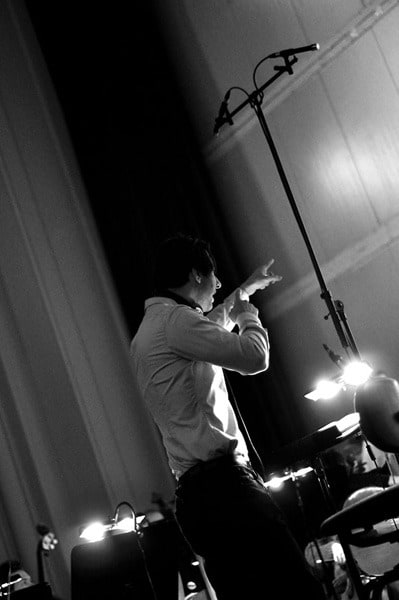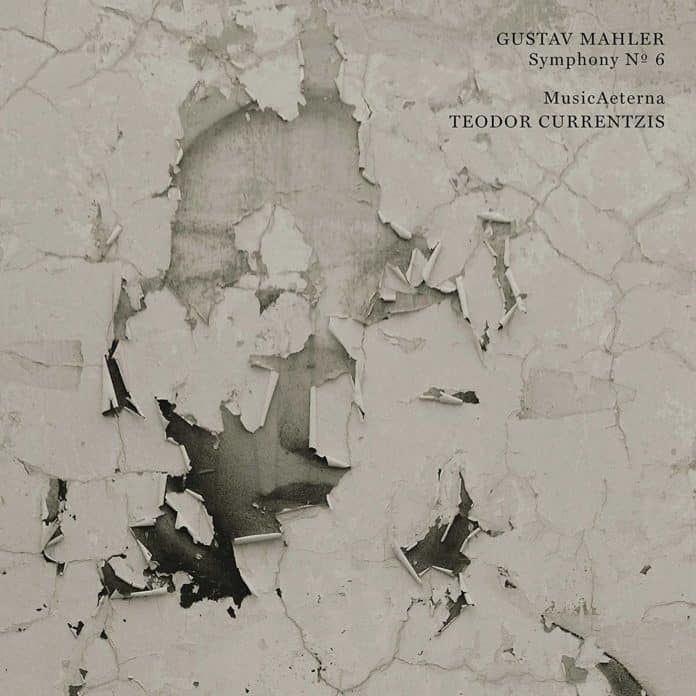Review:
Mahler, Symphony 6 “Tragic”
MusicAeterna
Teodor Currentzis (conductor)
Sony Classical
This is not just another Mahler 6th. And this is no easy thing to say considering that the competition is fierce: Bernstein on Sony and DG, Barbirolli, Karajan, Solti, Tennstedt, Sanderling, Jansons/LSO, Abbado/BPO. So how is Currentzis different? This will come as a shock to some, but his orchestra actually sounds better than many world-renowned ensembles. To begin with, individually, the instrumental contributions are more characterful. This is no routine playing and the winds and brass in all movements are a testament to this. Not to mention the uniformity of the strings, here antiphonally placed, never excessive but still weighty and finely sculpted (in a way reminiscent of Karajan). But it’s not just all about great orchestral playing. Currentzis manages to bring out the musicality in a symphony where the term musicality doesn’t sound so apt.
To my ears, the shaping of the opening reminded me of Sanderling, whose recording has been considered the yardstick by many. The march has the extra bite needed that is missing in most recordings, the strings dark-hued. The depth of playing, the presence and execution of the snare drums make this a march that breathes with life, so much that when the exposition repeat arrives it sounds like fresh material. Not to mention the measured approach to the Alma theme, which here is emotional without being sentimental. And when the xylophone and glockenspiel enter towards the end of the movement you will be left wondering: has this passage ever sounded more dreamy? “A dreamy military march?” I hear you ask. Indeed. This is a first movement with the raw power of Barbirolli and the vision of Karajan. After all, Mahler himself commented on the middle-part cowbell section saying these are the “last earthly sounds heard from the valley below by the departing spirit on the mountain top”.

The Scherzo, placed 2nd, is equally, successful. How so? The altväterisch theme of the Trio has all the innocence one would expect (Alma described it as a game of children zig-zagging through the sand) but it is the Scherzo sections with the mocking brass that stand out. Conductor and orchestra make this movement sound more burlesque than menacing (compared to Solti for instance). The orchestral contributions from the woodwinds have a mature, ripe quality: kudos to the oboe which really has a very distinctive sound that fits the dark, comical character of the piece.
In the Andante Moderato all the boxes are ticked: Currentzis observes the sloping string glissandos (at 10:27 and 10:54) which are handled here with utmost care and which are missing from even some benchmark recordings. As mentioned above, the antiphonal string decks help the sound spread uniformly and their interplay is vividly caught across the soundstage (listen for example from 12:43 to 12:50). I’d like to put particular emphasis on the cowbells which are here realistically recorded. Once more I quote the composer, who specifically stated the cowbells “should be played with discretion—so as to produce a realistic impression of a grazing herd of cattle, coming from a distance…”. This might sound like a trivial observation but in some recordings, they are either swamped by the orchestra in certain loud passages (Solti) or they are too artificial-sounding to the point of not resembling the actual sound of cowbells (Chailly)—not to mention recordings where the cowbells are too congested (after all, Mahler said grazing cattle, not cattle fighting each other). It is indeed rare to hear the pastoral elements of the Andante brought out with such subtlety as in this recording. This is the beauty of nature filtered through the human senses and, as everything unattainable, it is inexorably linked to pain. And the current performance manages to capture a great deal of the fragile qualities of this relationship.
But for me, the highlight of the movement (and one of the highlights of this release) is how Currentzis treats the central climax and how, right after that, the second theme returns in full glory from the strings towards the end. He respects and brings out the humanity of the piece instead of lingering too much on the pathos in an almost clear, ascetic way. Very few performances succeed in offering such an honest account of the big theme in the Andante, Karajan and Herbig being among them.
Which brings us to the Finale, arguably the pinnacle of the symphony. Everything culminates here. And under Currentzis the level of detail is astonishing. The subdued crescendo at the beginning of the movement might initially worry some, but after a while one realises it matches Currentzis’s overall approach. It is no exaggeration to say that the way the conductor manages silence here—dare I say that Currentzis manages to sculpt silence?—is unique.
Sony Classical Album Preview
On the present release, the Finale sounds like music that at times seems to have emerged somewhere between the two Nachtmusik movements of the 7th and the subconscious world of lucid dreaming. The brass is sizzling, the string tremolandi often hold the tension mid-air, the triangle and cowbells here as if coming from a dark distance. The two hammer blows—here sounding “brief and mighty, but dull in resonance and with a non-metallic character (like the fall of an axe),” exactly like Mahler suggests—are followed by a manic accelerando right afterwards (other performances don’t resort to this frenzy which Currentzis holds under his control without getting carried away). And how gracefully the same theme slows down again when the harp and triangle enter. Of course, “gracefully” is an odd word to use for this movement, but in a way this is how Currentzis handles the finale.
In short, don’t expect Solti’s menacing timpani and driven tempos. This is a Finale where the pastoral element is evident (!) and parts of which seem to come from Mahler’s 5th and 7th symphonies (thus making the final movement, especially, sound like an arch between the two). And perhaps this finale makes one understand, better than any other recording that I know of, what Tom Service is referring to in his Guardian Symphony Guide when he says that “if you hear the piece, thinking only of the implacable darkness with which it ends, you miss the true drama, which is that a completely different emotional outcome is possible until the final few minutes. Everything is at stake right until the end of this music, and it’s the fact that this symphony consistently strives for a victory that it doesn’t ultimately win that makes it so emotionally devastating; in that sense, this symphony is the exact opposite of ‘nihilistic’.)”
The reader will notice that I haven’t mentioned any weaknesses and it turns out that one or two points that initially puzzled me, made complete sense only a few seconds later as the music progressed (in fact the opposite thing happened: after comparing multiple recordings, I noticed instead shortcomings with some of the “legendary” performances I used to cherish myself). And whilst in other performances one might expect to hear what the conductor is going to do with the louder parts, with Currentzis one is anticipating the quieter ones.
On a personal level, let’s just say that Currentzis’s interpretation is of such depth that it helped me re-appreciate this mighty symphony. The way he shapes the Andante and the Finale, in particular, bringing out the light and grace within this darkest work, made me realise that such revealing detail, without sacrificing the composer’s intentions, is what great interpretation in classical music is all about. Currentzis states in the booklet notes (at last a CD with original and illuminating insights on the work) that the finale offers a sort of catharsis and this is clear from his interpretation. Death does not come after the end of the 6th. I would extend this to add that a new world of possibilities begins. And perhaps new possibilities in music.
As mentioned earlier the MusicAeterna is a match to any world-class orchestra and surpasses most of them if we are to judge from the present recording. And speaking of recordings, as in Currentzis’s previous release of the Tchaikovsky 6th, the recorded sound here not only is state-of-the-art, but it also has the ideal reverb (this is one of the very best sounding Mahler recordings).
In the 6th I’d personally choose Solti or Karajan (two antithetical approaches), Bernstein for the sheer drama in the finale, Jansons for a more straightforward approach that still encompasses Mahler’s reality. But Currentzis has achieved here something unique that I never thought I would hear in this symphony. The musicality and radiance of this performance is unrivalled. I would dare say that this is a Mahler 6th for the ages which goes directly to the top of my list.
Rating: ***** (5/5 Gold)








Interesting. I must admit I have yet to find a Currentzis recording I really like. They are always interesting, but I’m never fully convinced. Will need to check this one out.
It amazes me that the reviewer thinks the recorded sound is state-of-the-art. To my ears, it sounds like a limiter was applied to the volume, so everything from mf to ffff sounds the same. Cymbal crashes and hammer strokes don’t have any impact. Furthermore, the sound stage shifts noticeably multiple times during the first movement alone. Try, for example, 1:04 and 3:50 in the first movement. First the soundstage widens, then it shifts back to the centre, for no apparent (musical) reason. Instruments can sound almost unrealistically close-by one moment and then come from the back of the stage moments after (especially string sections). All in all, it sounds like a recording patched together with a lot of spot-miking. To me, it sounds unrealistic. It’s like the recording engineer doesn’t trust Mahler’s scoring.
But the flattening of every climax because of the limited dynamic range is actually more detrimental. I know of no modern Mahler 6 with such limited dynamics. In terms of dynamics, it sounds like a FM radio broadcast. Heck, Barbirolli from 1967 has more realistic relative dynamics than this one from 2018…. Those two drawbacks combined sadly rob the music of emotional impact. I say sadly, because the performance itself is very, very good. If only it would have been recorded without all this gimmickry. Does the reviewer really not hear this?
Mdvp, thanks for the comment.
Different people hear different things. I’ve listened to the examples you cite (1:04 and 3:50). To my ears this is very good stereo separation of the soundstage. This happens a lot of times in the recording: you can hear the instruments exactly where they are placed (OK, you can imagine them being placed there). The same soundstage treatment, where the focus *seems * to change could be said about the recent Nezet-Seguin/Trifonon Rachmaninov 2nd and 4th, which I have also reviewed recently. To my ears it is just very good soundstage separation.
Please do read my review of the Nelsons CD (https://echoaftersilence.com/nelsons-shostakovich-symphonies-4-11/) where I cite examples where the engineers (possibly) tinker with the volume and most reviews don’t even mention that but instead speak of state of the art sound. Friends of mine and I do hear these “glitches” in the Nelsons — so even though I can say 100% that I hear them, you will read reviews that state the opposite. Another thing is that people prefer different kinds of recordings. An example: most reviewers (including myself) found the Tchaikovsky 6th by Currentzis splendidly recorded. But then they were a couple who spoke of too much manipulation in the editing studio and said it doesn’t sound like a live concert. I think it all comes down to how “natural” or “studio” sounding you like your recordings. Some people like them with little soundstage separation and editing, others like the multi-mike treatment. (I usually prefer studio recordings where things can be edited, mixed and re-mixed and which have been recorded with nearly ideal placement of microphones).
You mention Barbirolli, whose sound separation in Mahler sounds to my ears to closest thing to what Currentzis’s engineering teams have been achieving in their albums so far: a sound separation that does not mimic the live concert but sounds absolutely wonderful on CD. It’s strange that you you mention Barbirolli in the first place because the first time I heard both the Currentzis’s Tchaikovsky and Mahler CDs, the Barbirolli recording effect immediately came to my mind! So this point also proves how different people hear different things.
What I disagree with is the limited dynamics that you mention. The timpani are subdued in parts of the last movement because this is the conductor’s approach (to prove this: in the first movement their impact is better than in most recordings).
But thank you for your comment, it made me re-listen to the whole recording once more (and to the timings you mention) and realise that it all comes down to *how* concert-like one prefers their recordings to sound and I am afraid my opinion remains the same: this is one of the best sounding Mahler recordings with great sound separation.
Thanks for your reply. Don’t get me wrong, I’m all for good instrument separation and wide soundstages, and I think that the recording does a *very* good job at that (sounds indeed like Barbirolli). But at the moments I specified (and a few more), the soundstage shifts. You can literally hear the recording engineer turning the knob on his mixing panel (at 1:04 *poof*, suddenly a much wider soundstage, in the middle of a phrase, and at 3:50 *poof* again, gone is the wider soundstage). It almost sounds like the sound engineer tried something and forgot to remove or smooth out this edit in the final product. It’s jarring and unprofessional to hear something like that in a commercially available recording.
As for the dynamic range, just listen to either one of the hammer blows or the final ‘bang’ of the finale. You can hear the volume ‘bounce back’ after those severely compressed moments. In case of the final ‘bang’ it gives the bizarre effect of a crescendo after the bang, instead of a decrescendo, because of the ‘recoil’ of relative dynamics. Which is to say, this recording is mastered like pop album from the worst years of the loudness wars, not like a proper classical recording. At least in Barbirolli’s recording, you can hear the microphone distortion at climaxes, which is actually less detrimental then hearing a modern recording, perfectly capable of capturing the power of those moments, consciously being knee-capped by applying heavy compression. Compared to Bernstein with Vienna for example (a recording from the eighties!), where all the big moments really knock you out of your seat, Currentzis sounds tame. The performance is there (obviously the orchestra is very well prepared, and Currentzis knows what he wants and gets it), but the recording has no torque. I personally cannot listen to it. I envy you that you can.
I loved his Tchaikovsky 6 by the way, which is also an amazing performance, but there, too, the dynamics are gone from all the louder parts.